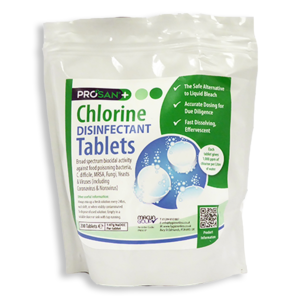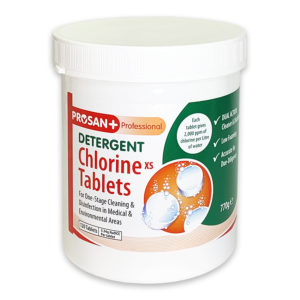Description
Effervescent Chlorine Tablets – 2.5g NaDCC
A 3.5g tablet containing 2.5g sodium dichloroisocyanurate (NaDCC) which gives 1,500 ppm available chlorine per litre of water. * Fast Dissolving – Pre dissolve in a little warm water to speed up dissolution time * 18mm diameter, 200 per tamper evident tub, packed 6 per case. USES AND EFFECTIVENESS – Effervescent Chlorine Tablet (ECT) PRODUCT APPLICATIONS: 3.5g Effervescent Chlorine Tablets (2.5g NaDCC): Typical Uses in Private & Public Health areas:
- Non metallic medical and veterinary appliances
- Mops, cloths and glassware
- General disinfection
- Body fluid spills
- Drains, sinks, W.C. pans, W.C.’s
- Laboratory discard jars
- Conditions of heavy soiling
- Veterinary hygiene:
- General hygiene
- Conditions of heavy soiling
- Food and feed disinfectants:
- Food preparation areas; non metallic equipment, containers, consumption utensils, work surfaces, stainless steel (catering grade)
- Baby bottle sterilisation
- Disinfection of salads, vegetables, non-peelable fruit
- Drinking water disinfection:
- Chlorination of animals drinking water
- Emergency water purification
Use dilutions, including descriptions of the proposed method of application.
| DILUTION TABLE 3.5g ECT (2.5g NaDCC) | ||
| 1 TABLET IN | GIVES AVAILABLE CHLORINE OF | TYPICAL USES |
| 150ml | 10,000 ppm | Body fluid spills & conditions of heavy soiling |
| 600ml | 2,500 ppm | Non metallic medical & veterinary appliances & laboratory discard jars |
| 1.5 litre | 1000 ppm | General disinfection |
| 3.75 litres | 400 ppm | WC’s, drains, sinks |
| 7.5 litres | 200 ppm | Food preparation areas |
| 12 litres | 125 ppm | Baby bottle sterilisation |
| 15 litres | 100 ppm | Cloths & mops |
Guidelines for the use of 3.5g ECT for glassware, mops and cloths: After cleaning mops or cloths, dissolve 1 tablet in the recommended amount of water to produce 100ppm of available chlorine. Immerse the cloth or mop in the solution for at least 30 minutes. Do not leave overnight. Guidelines for the use of 3.5g ECT for food preparation surfaces and food processing equipment: Remove loose debris with a clean, loosely-folded cloth. Wash with a hot neutral detergent solution and cloth. An abrasive nylon pad may also be useful. Rinse with hot water and a clean cloth. Drop one 3.5g ECT into the recommended amount of water, preferably warm (40°C) to provide 200 ppm of available chlorine. (Warm water assists the process of disinfection and also speeds up the tablet dissolution time.) Thoroughly wet the cleaned surface with the disinfecting solution by the most suitable means, e.g. trigger spray or disposable cloth. Leave wet for a minimum of 3 minutes. (Providing the surface is thoroughly clean this is sufficient contact time for positive disinfection.) Rinse off with fresh, clean water. Allow to air-dry or use disposable paper towel. IN THE CASE OF DANGEROUS OR ELECTRICAL EQUIPMENT (E.G. SLICING MACHINES), PRELIMINARY SAFETY PROCEDURES AND FINAL SAFETY CHECKS WILL BE REQUIRED, SEVERAL TYPES OF EQUIPMENT WILL NEED PARTIAL OR COMPLETE DISMANTLING TO ENSURE EFFECTIVE CLEANING AND DISINFECTION. WARNING: TO BE EFFECTIVE, DISINFECTANT SOLUTIONS MUST BE MADE UP FRESH EACH DAY AND BE OF CORRECT CONCENTRATION. Guidelines for the preparation of 3.5g Effervescent chlorine tablets for washing salads, vegetables and non-peelable fruit. Where Fresh Produce is Consumed within 24 Hours of Washing: Remove as much dirt and debris from the vegetables and fruit as possible by thoroughly rinsing in cold fresh drinking water. Prepare the Prosan 3.5g ECT solution by adding the appropriate quantity of tablets to the recommended volume of water to give the required amount of free available chlorine in solution according to the recommended contact time. Where possible, try to ensure that the temperature of the rinse water is greater than that of the fresh produce (ideally 10°C higher). In practice potable tap water from the mains supply is satisfactory. Add the vegetables or fruit to the solution for the recommended contact time. Ensure produce is completely submerged. Agitate produce to remove excess air bubbles. Fruit or vegetables should be eaten as soon as possible after washing. It is preferable not to rinse after washing, except where the food will be consumed in <2 hours, in which case rinse with clean, fresh potable drinking water. If storage is required, remove the produce from solution and shake off excess liquid. If possible, spin dry. Place in a sealable polythene bag or an equivalent air-tight container and store under refrigerated conditions at 4 to 8°C for as short a period as possible (<24 hours). Some produce, which is grown under heavily contaminated conditions, i.e. cress, peppers, requires the solution strength to be doubled. Where storage of Fresh Produce is Required for >1day
- Remove as much dirt and debris from the vegetables and fruit as possible by thoroughly rinsing in cold fresh drinking water
- Prepare the ECT solution by adding the appropriate quantity of tablets to the recommended volume of water to give the required amount of free available chlorine in solution according to the recommended contact time. Where possible, try to ensure that the temperature of the rinse water is greater than that of the fresh produce (ideally 10°C higher). In practice potable tap water from the mains supply is satisfactory.
- Add the vegetables or fruit to the solution for the recommended contact time. Ensure produce is completely submerged. Agitate produce to remove excess air bubbles.
- Remove from solution and rinse with potable water. Shake off as much excess water as possible from the produce. If possible, spin dry. Place on clean dry trays and store under refrigerated conditions at 4 to 8°C for as short a period as possible.
- Immediately before use, remove the fresh produce from storage and rinse with potable water.
- Some produce, which is grown under heavily contaminated conditions, i.e. cress, peppers, requires the solution strength to be doubled.
- Additional information for fruit and vegetable handling guidance has been provided by the Sandwich and Salad Association (Appendix 2, 2001).
Number of application times and contact times and, if necessary or applicable, all special and specific information relevant to the geographical and climatic fluctuations or necessary waiting times for the protection of human beings or animals: DISINFECTION OF SALADS, VEGETABLES, NON PEELABLE FRUIT
| 3.5g (2.5g NaDCC) Effervescent Chlorine TabletSALAD & VEG WASH DOSING CHART | ||
| CATERING: Where there is only a short period of time between preparation and consumption of the food. ppm=Parts Per Million | ||
| No of tablets per 60 Litre water | Gives available chlorine of: | Suggested Contact Time: |
| 1 | 25 ppm | 15 mins & rinse |
| 2 | 50 ppm | 10 Mins & rinse |
| 3 | 75 ppm | 5 Mins & rinse |
| IN FLIGHT CATERING & THE SANDWICH MAKING INDUSTRY: Where there is a lengthy time lapse between preparation and consumption. (No rinse required) | ||
| 2 | 50 ppm | 15 mins & air dry |
| 4 | 75 ppm | 10 Mins & air dry |
| 6 | 150 ppm | 5 Mins & air dry |
Instructions for the use of Tablets in Hospitals:
| 3.5g (2.5g NaDCC) Effervescent Chlorine Tablets –Typical Hospital Usage | |||
| 1 Tablet in: | Gives Available Chlorine of: | Task: | Method: |
| 150 ml | 10,000 ppm | Body Fluid Spills | Leave for 2 Mins |
| 600 ml | 2,500 ppm | Laboratory Discard Jars | Soak Overnight |
| 1.5 Litres | 1,000 ppm | General Disinfection(High Risk Areas) | 15 Min Contact Time |
| 3.75 Litres | 400 ppm | Drains, W.C’s, Sinks etc | Pour in at quiet times |
| 12 Litres | 125 ppm | Baby Bottles Sterilising | Min 30 Mins |
| 15 Litres | 100 ppm | Cloths Mops etc | 30 Minutes. Do not leave overnight |
The dilutions for Catering applications are: Hard surface disinfection post cleaning – 1 tablet in 7.5 litres of water to give 200 ppm. Min 3 minutes, allow to air dry or use clean paper towels. NOTE: All of the above information is offered without any implied warranty or indemnity. The user should satisfy themselves that the product is being used in accordance with local guidelines and instructions.
FOGGING: If you are using tablets to create a HOCl solution, 1 tablet in 1.5 Litres Water gives 1,000 parts per million available chlorine (HoCl). TECHNICAL: Hypochlorous acid (HOCl or HClO) is a weak acid that forms when chlorine dissolves in water, and itself partially dissociates, forming hypochlorite, ClO−. HClO and ClO− are oxidizers, and the primary disinfection agents of chlorine solutions.





